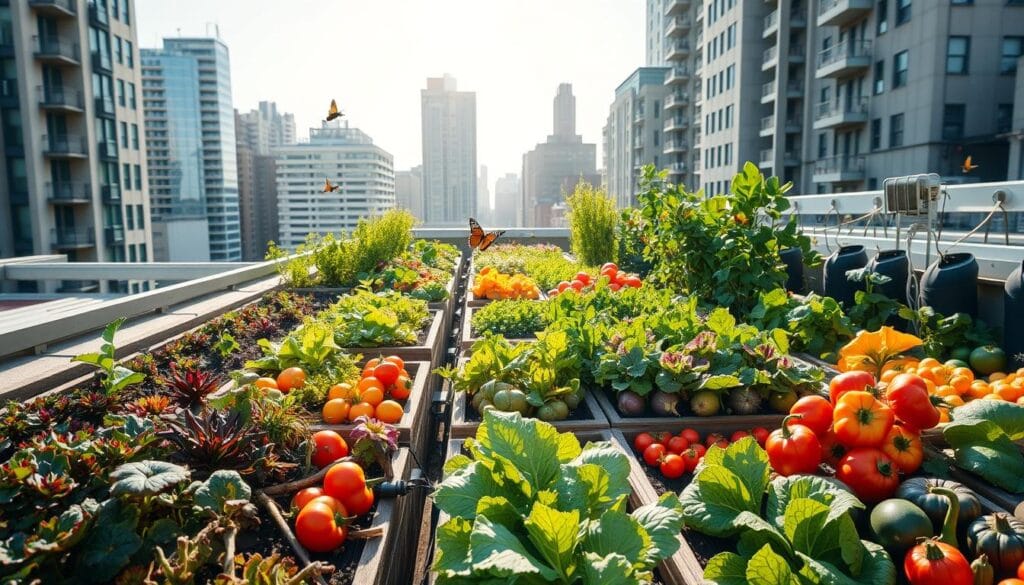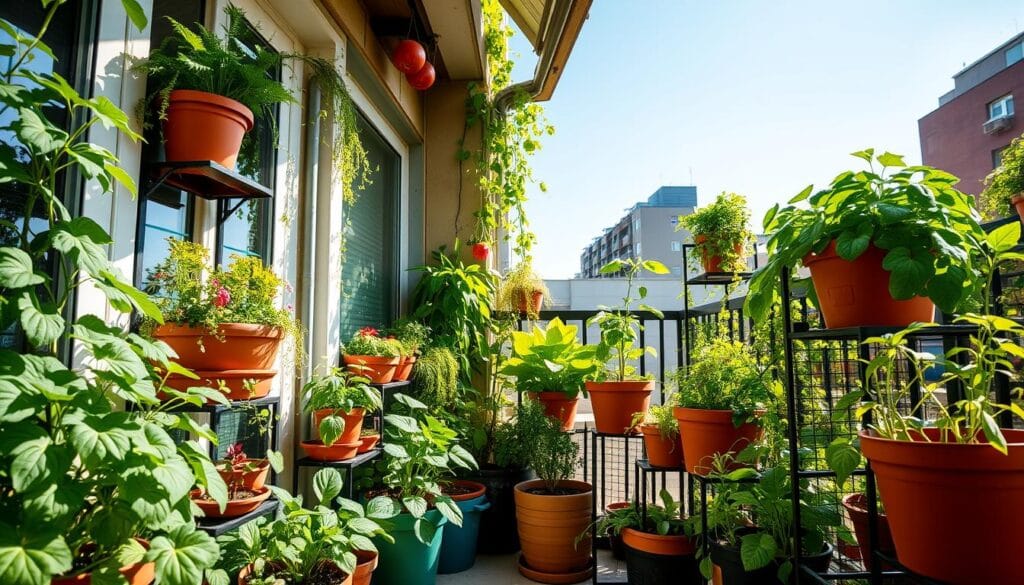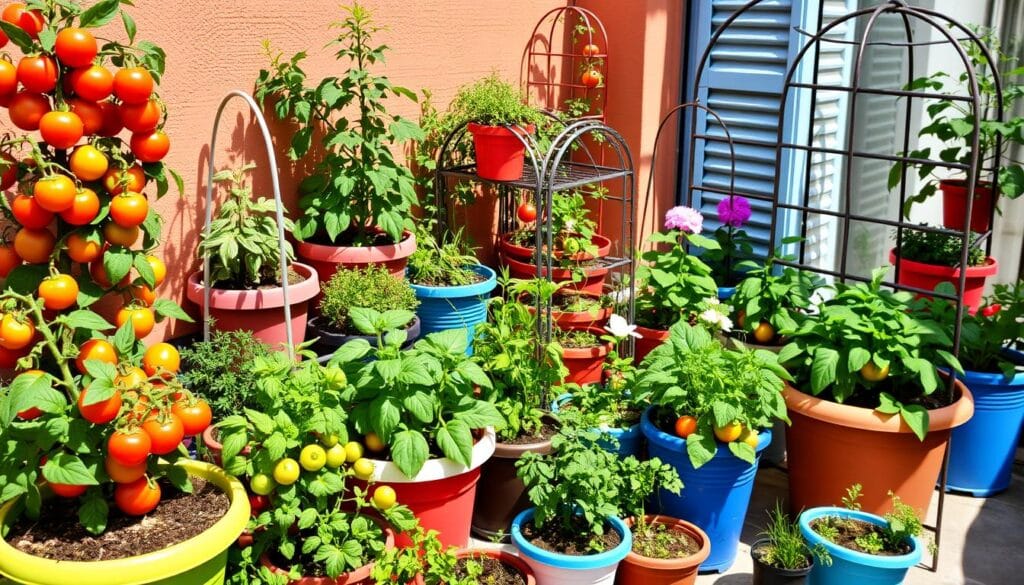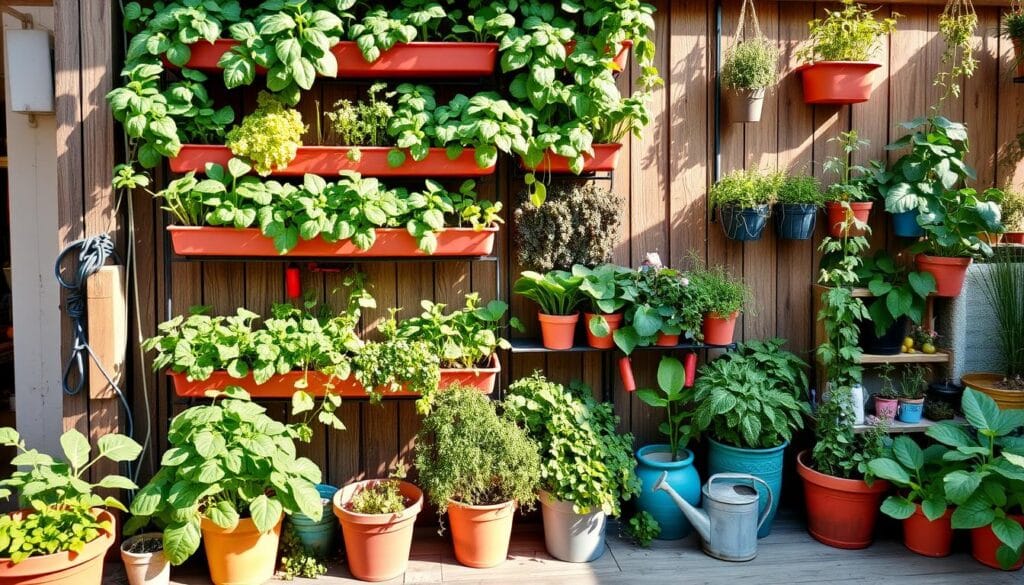Imagine having a thriving Vegetable Garden in Small Spaces, where you can grow your fresh produce, even in the smallest of areas. This idea of small-space gardening is becoming more popular in urban areas. With the right techniques and planning, you can make a productive garden, using every inch of space and enjoying homegrown veggies.
Starting small is key to a successful Vegetable Garden in Small Spaces. Many beginners start with a garden that’s too big. But, a 10′ x 10′ plot is perfect for beginners. It’s big enough to be productive but small enough to manage.
In a small garden, knowing each vegetable’s needs is vital. This means picking the right seeds and plants, using trellises for vertical space, and buying plants locally. By doing these things, you can make a thriving Vegetable Garden in Small Spaces. You’ll enjoy fresh produce and the joy of growing your food.
Key Takeaways
- Start small, with a plot size of 10′ x 10′ for beginning gardeners
- Understand the characteristics of each vegetable before growing
- Use trellises to add vertical growing space in small gardens
- Buy vegetable plants locally for better performance
- Select the right seeds and plants for a successful harvest in your Vegetable Garden in Small Spaces
- Maximize your space with small-space gardening and urban gardening techniques
- Enjoy the benefits of fresh produce and the satisfaction of growing your food in a small garden
Understanding the Benefits of a Small Vegetable Garden
Starting a small vegetable garden can change your life. Urban, container, and balcony gardening are gaining fans. They help people grow their food, reducing their need for industrial farms.
This shift cuts down on greenhouse gas emissions and food waste. The American Community Gardening Association notes that 18,000 community gardens exist in the U.S. and Canada. These gardens show how to grow food sustainably.

- Fresh produce at your fingertips, reducing your reliance on industrial agriculture
- Reduced environmental impact, including lower greenhouse gas emissions and waste from food production
- Cost savings, as you can grow your food and reduce your grocery bills
Small vegetable gardens are a step towards a greener, more self-sufficient life. They work for urban, container, or balcony gardening.
Choosing the Right Location
When you’re gardening in small spaces, picking the right spot is key. Think about how much sun your garden will get and how easy it is to reach. Some veggies need lots of sun, while others do well in partial shade.
To get the most out of your space, use compact vegetable garden designs. Square foot gardening can also help you grow more in less space. It’s all about making every inch count.
Sunlight Requirements
Tomatoes, eggplants, and squash need at least 6 hours of sun a day. But, lettuce, spinach, and herbs can do well with just 3-4 hours of direct sun. Knowing what your plants need will help you pick the best spot.
Accessibility and Water Source
Having your garden in a spot that’s easy to get to and close to water is important. Think about how far your garden is from water and how easy it is to get to. Even small spaces, like balconies or patios, can be great for gardens.

By picking the right spot and knowing what your plants need, you can have a thriving garden. Whether you’re using square-foot gardening or other designs, planning carefully is the secret to success.
| Plant Type | Sunlight Requirements |
|---|---|
| Fruit-producing plants | More than half a day of full sun |
| Leafy greens and herbs | Partial shade to full sun |
| Root vegetables | Partial shade to full sun |
Selecting the Best Vegetables for Small Spaces
Choosing the right vegetables is key for a good harvest in small spaces. You can grow many vegetables in tight spots, like container gardening and balcony gardening. Look for compact varieties like green beans, pole beans, and cucumbers. They do well in small areas with the right care.
For vertical gardening, pick vining plants like winter squash and cucumbers. They can climb up trellises or supports. These plants are great for small spaces and can be picked often to keep them growing. Leafy greens like lettuce and herbs like basil and parsley are also good choices.

- Choose compact or dwarf varieties of vegetables that are bred for small spaces.
- Consider the mature size of the plant and leave enough space for it to grow.
- Look for varieties that are resistant to disease and pests, which can be a major problem in small spaces.
- Plant a mix of fast-growing and slow-growing vegetables to ensure a continuous harvest.
By following these tips and choosing the right vegetables, you can enjoy a full harvest. This will make the most of your container gardening, balcony gardening, or vertical gardening setup.
Planning Your Garden Layout
When planning your garden, think about the space you have and the veggies you want to grow. Use vertical gardening like trellises or wall planters to save space. Square-foot gardening also works well by dividing the garden into small sections.
Here are some tips for planning your garden:
- Choose a spot that gets full sun (at least 6 hours a day).
- Look for soil that drains well and is easy to reach water.
- For small spaces, consider raised beds or container gardening.
A good garden plan lets you grow many veggies, even in tight spots. Use vertical and square-foot gardening to make a compact garden. This way, you can enjoy fresh veggies with your family.

| Garden Layout Plan | Description |
|---|---|
| Four Square Vegetable Garden Layout Plan | Divide the garden into 4 sections for crop rotation and soil health. |
| Square Foot Vegetable Garden Layout Plan | Divide the garden into equal 4 x 4 plots for efficient use of space. |
| Rows Vegetable Garden Layout Plan | Plant vegetables in evenly spaced rows for proper sunlight and air circulation. |
Preparing the Soil for Planting
Preparing the soil is key in small space, urban, and container gardening. You want your plants to grow well. Start by testing your soil to know its quality and pH level.
Soil in small spaces can lose nutrients quickly. Add compost or manure to enrich it. This improves the soil’s structure and gives your plants what they need. For container gardening, a good potting mix is also important.
Testing Soil Quality
Testing your soil is easy with a DIY kit or lab analysis. The results show your soil’s pH, nutrients, and composition. This info helps you prepare your soil for planting.
Enriching Your Soil
There are many ways to enrich your soil. Add organic matter, use fertilizers, and rotate crops. For small and urban gardening, balance is key to avoid over-fertilizing. Proper soil preparation leads to healthy plants and plenty of produce.
- Adding a 2-inch layer of compost or well-rotted manure to your soil
- Using a balanced fertilizer that contains essential nutrients such as nitrogen, phosphorus, and potassium
- Practicing crop rotation to avoid depleting the soil of specific nutrients
| Soil Type | Characteristics | Preparation Tips |
|---|---|---|
| Sandy Soil | Minimal preparation is needed, but can benefit from added organic matter | Add organic matter to improve water-holding capacity |
| Clay Soil | Holds moisture, can be dense | Add compost or well-rotted manure to improve drainage |
| Loamy Soil | Well-balanced, fertile | Minimal preparation is needed but can benefit from added organic matter |
Effective Watering Strategies
Watering plants on balconies, in vertical gardens, or small vegetable plots can be tricky. It’s key to know how much water each plant needs. Most vegetables and herbs need 1 to 2 inches of water each week. This water should be spread out over 1 to 3 times.
The type of soil in your garden affects how often you need to water. Sandy soil needs more water but in smaller amounts. Clay soil does better with slow watering, like drip irrigation. Silty soil prefers lighter, more frequent watering.
When planning your garden, think about how much water each plant needs. Tomatoes and cucumbers need about 2 inches of water weekly. Peas only need 1 inch. Plants with shallow roots, like cucumbers and carrots, might need water every day in hot weather.
Drip Irrigation Systems
Drip irrigation systems are great for delivering water right to the roots. This cuts down on evaporation and runoff. They’re perfect for small spaces, like balconies and compact gardens.
Watering Schedules
Having a watering schedule is important for your plants. Consider their needs based on soil type, climate, and growth stage. This way, you can create a lush and productive garden, whether it’s vertical or traditional.
Pest Control for Your Small Garden
When you garden in a small space, keeping pests away is key. You can use natural methods and plant friends to fight pests. This way, you protect your garden without harming the environment.
For example, diatomaceous earth can keep pill bugs, slugs, and snails away. A mix of dish soap and water can also stop white flies. Companion planting is another smart move. Plants like marigolds, onions, and garlic can keep pests at bay.
Here are more tips for keeping pests out of your small garden:
- Use ladybugs to control aphids and white flies
- Plant flowering herbs like lavender, thyme, and basil to attract pollinators
- Try beer traps to attract and trap pesky insects
By using these natural methods and planting wisely, you can keep pests away. This way, your small garden will thrive, giving you a great harvest.
| Pest | Natural Remedy |
|---|---|
| Aphids | Ladybugs |
| A mixture of dish soap and water | Mixture of dish soap and water |
| Pill bugs, slugs, and snails | Diatomaceous earth |
Harvesting Tips to Maximize Yield
When you care for your container, balcony, or vertical garden, think about harvesting. Knowing when and how to harvest can greatly improve your crop’s quality and amount.
For example, tomatoes and zucchini grow a lot, giving you plenty from one plant. But, cabbage and broccoli only give you one harvest. By picking the right plants for your space, you can get more from your garden.
Here are some important things to keep in mind for harvesting:
- Timing: Pick your veggies when they’re at their best taste and texture.
- Technique: Harvest carefully to protect your plants and future crops.
- Succession planting: Plant new seeds or seedlings often to keep a steady harvest all season.
By using these tips for your garden, you can have a successful harvest, even in small spaces. Always check the best practices for your area to get the most from your garden.
Sustainable Practices for Small Gardens
As you care for your small garden, it’s key to use sustainable practices. These practices help keep your garden healthy and productive. Small gardens let you control the ecosystem, which is good for you and the planet.
Composting is vital in small gardens. It turns food and yard waste into nutrient-rich soil. This helps plants grow well. It also cuts down on waste and greenhouse gases.
Composting in Small Spaces
There are many ways to compost in small spaces. You can use vermicomposting, bokashi, or a compact bin. These methods are perfect for urban gardens or small vegetable plots. They help reduce waste and make soil better for plants.
Crop Rotation Techniques
Crop rotation is another important practice. It keeps the soil healthy, fights pests, and boosts biodiversity. In small gardens, you can divide the space and rotate crops seasonally. This saves on fertilizers and pesticides.
By using these practices, your small garden will flourish. Always focus on soil health, reduce waste, and encourage biodiversity. This way, your garden will be good for you and the planet.
| Sustainable Practice | Benefits |
|---|---|
| Composting | Reduces waste, creates nutrient-rich soil amendment |
| Crop Rotation | Maintains soil fertility, reduces pests and diseases, promotes biodiversity |
Seasonal Considerations for Small Vegetable Gardens
Starting a small garden in your apartment, using vertical gardening, or growing a compact vegetable garden is exciting. It’s important to think about the seasons and how they affect your garden. Knowing what your plants need at different times of the year helps you grow more and enjoy fresh food all the time.
Year-Round Gardening Strategies
Even with a small space, you can grow a lot of food all year. Try succession planting to keep a steady supply of veggies. Also, consider vertical and container gardening to make the most of your space.
Seasonal Planting Guide
Knowing when to plant different vegetables is key to a successful garden. A seasonal planting guide helps you plan. It considers things like weather, sunlight, and soil. This way, your garden will be productive all year, and you’ll get to enjoy your harvest.
FAQ
What are the benefits of having a small vegetable garden?
A small vegetable garden gives you fresh produce all the time. It also helps the environment and saves money on food.
What should I consider when choosing a location for my small vegetable garden?
When picking a spot for your garden, think about sunlight, easy access, and water nearby.
What are the best vegetables to grow in a small space?
For small spaces, grow compact and quick-growing veggies like cherry tomatoes, dwarf beans, and leafy greens.
How can I maximize the space in my small vegetable garden?
To use space well, try vertical gardening, raised beds, and growing in containers.
How do I prepare the soil for my small vegetable garden?
Start by testing your soil and adding compost or organic matter to make it better.
How can I efficiently water my small vegetable garden?
Use drip irrigation and a watering schedule to water your garden smartly.
How can I control pests in my small vegetable garden?
Use natural pest control and plant veggies together to keep pests away.
When should I harvest my vegetables?
Harvest your veggies at the right time and use the right methods to get the most.
How can I implement sustainable practices in my small vegetable garden?
Use composting and crop rotation to keep your garden healthy and productive.
How can I plan my small vegetable garden for maximum productivity year-round?
Plan for year-round growth by using strategies and a seasonal planting guide.
Source Links
- How to start a small vegetable garden and make the most of it – https://www.creativevegetablegardener.com/how-to-start-a-small-vegetable-garden/
- 11 Small Vegetable Garden Ideas for Maximizing Your Homegrown Harvest – https://www.bhg.com/small-vegetable-garden-ideas-8602619
- 15 Tips For Vegetable Gardening in Small Spaces – https://www.epicgardening.com/gardening-limited-space/
- Public Health Benefits of Community Gardens – School of Public Health – https://publichealth.tulane.edu/blog/benefits-of-community-gardens/
- Vegetable Gardening for Beginners: The Complete Guide – https://www.almanac.com/vegetable-gardening-for-beginners
- Small Vegetable Garden Plans and Layouts – https://www.almanac.com/small-vegetable-garden-plans-and-layouts
- Growing Vegetables in Small Spaces – Gingham Gardens – https://ginghamgardens.com/growing-vegetables-in-small-spaces/
- Easiest Vegetables to Grow in Containers & Small Space Gardening Tips – https://zerowastehomestead.com/how-to-grow-vegetables-in-a-small-space-container-garden/
- Best Vegetables to Grow in Small Spaces – https://my-indiana-home.com/home-and-garden/best-vegetables-to-grow-in-small-spaces/
- 9 Cut And Come Again Crops For Small Spaces – https://www.gardeningknowhow.com/edible/vegetables/cut-and-come-again-crops-for-small-spaces
- The Top 4 Vegetable Garden Layout Ideas – Westwood Gardens – https://www.westwoodgardens.com/blog/top-4-vegetable-garden-layout-ideas
- We Share the Best Vegetable Garden Layouts to Try (Even Without Much Space) – https://www.thespruce.com/vegetable-garden-layout-8600906
- How to Prep Soil for a Vegetable Garden – https://www.familyhandyman.com/list/how-to-prep-soil-for-a-vegetable-garden/?srsltid=AfmBOooeVwf00chh_I1g2JBb9tr-S66fiwBf2AhALvfdKfEioqibsa0p
- How to Grow Fruit & Vegetables in Small Spaces: Complete Guide – Urban Turnip – https://www.urbanturnip.org/small-space-gardening/
- How to Water a Vegetable Garden From Seedling to Harvest – https://www.lawnstarter.com/blog/gardening-2/how-to-water-vegetable-garden/
- How to Water ⋆ Edible Backyard – https://www.ediblebackyard.co.nz/water-like-a-pro/
- 5 Pollinator-Friendly Ways You Can Manage Garden Pests | U.S. Fish & Wildlife Service – https://www.fws.gov/story/5-pollinator-friendly-ways-you-can-manage-garden-pests
- Organic Pest Control for the Garden – https://melissaknorris.com/podcast/organic-pest-control-for-vegetable-gardens/
- Companion Gardening Guide: Companion Planting for Garden Pest Control – https://zerowastehomestead.com/companion-gardening-guide-how-to-use-companion-planting-for-garden-pest-control/
- Want to Increase Your Garden Harvest? Learn This. – https://www.creativevegetablegardener.com/high-yield-crops/
- Turn a Small Garden Into a Big Harvest | Small Garden Tips | Mulhall’s – https://mulhalls.com/garden-home/blog/turning-a-small-garden-into-a-big-harvest/
- How to make a small, high-yielding vegetable garden – https://www.promixgardening.com/en/tips/highest-yield-vegetable-garden
- Tiny gardens, big harvests: Growing vegetables in small spaces – https://www.lsuagcenter.com/articles/page1717696392923
- Regenerative Gardening for Small Spaces and Container Gardens: Tips and Techniques – https://www.ecofriendlyhomestead.com/sustainable-garden/learn/regenerative-gardening-for-small-spaces-and-container-gardens-tips-and-techniques
- 15 Tips for Gardening in Small Spaces – https://www.epicgardening.com/gardening-small-spaces/
- Vegetable Gardening 101 – Gingham Gardens – https://ginghamgardens.com/vegetable-gardening/
- 3 Space-Saving Backyard Vegetable Garden Ideas – https://foodgardening.mequoda.com/daily/vegetable-gardening/space-saving-backyard-vegetable-garden-ideas/
- Small Patio Landscaping Ideas to Maximize Your Outdoor Space











